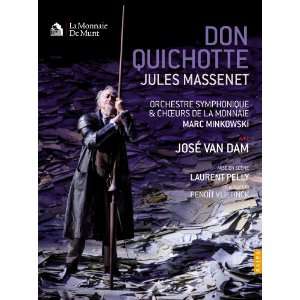|
Back
06/30/2012
Jules Massenet: Don Quichotte
José van Dam (Don Quichotte), Silvia Tro Santafé (Dulcinée), Werner van Mechelen (Sancho Pança), Julie Mossay (Pedro), Camille Merckx (Garcias), Gijs van der Linden (Juan), Vincent Delhoume (Rodriguez), Bernard Villiers (Ténébrun), Aldo de Vernati, Jacques Does, Gérard Lavalle and Pascal Macou (Four Bandits), Marc Coulon and André Grégoire (Two Valets), Symphony Orchestra and Choir of La Monnaie, Martino Faggiani (Chorus Master), Eric Robberecht (Concertmaster), Marc Minkowski (Conductor), Benoît Vlietinck (Video Director), Laurent Pelly (Director), Barbara de Limburg (Scenic Designer), Laurent Pelly (Costume Designer), Joël Adam (Lighting Designer), Jean-Jacques Delmotte (Collaboration on Costumes)
Recorded at the Théâtre Royal de La Monnaie, Brussels (May 2010) – 111’ (Bonus supplement: 61’)
Naïve #DR2147 (A co-production with RTBF, CANVAS and ARTE G.E.I.E.) – Booklet in English and French – Subtitles available in French, English and Dutch

   
It could be coined as the “Centenary Swan Song.” In commemoration of the 100th year anniversary of Jules Massenet’s comédie-héroïque who is best suited to grace the stage as the knight-errant than the illustrious José van Dam in his farewell address.
Laurent Pelly brings an edgy minimalism to his creations, and Don Quichotte is no exception. Commanding musical honesty to Massenet’s music, splendidly orchestrated and nicely paced under Marc Minkowski, the realm of imagination is flared beyond expected boundaries in a tasteful, artistic display. Mr. Pelly relishes details: Adam’s calculated lighting, Limburg’s plethora of Cervantes’ papers, likened to Welsh Dinorwic slate and Pelly’s anachronistic Tyvek© softened costume fabric that presents a chameleon conundrum against the first act’s geometrically apropos grounded Moorish wallpaper. The selected color palette is a combination of softened whites, yellows, beiges and grays with a dash of unexpected red contrast to suggest a mildly Bacchanalian flair in Act IV.
The curtain rises on Massenet, the composer, who subtly and fractionally transforms into the chivalric hero: half armor, half trench coat, flitting between reality and fantasy. Laurent Pelly has an incredible acumen, melding the paths of Cervantes, Massenet, Cain and Le Lorrain in unerring modernistic fashion.
Undoubtedly, the evening centers around José van Dam. Having filled the shoes of Don Quichotte in the past, Mr. van Dam embraces the stage with seasoned sophistication and softened approach. What is retained and continues to please audiences is his dignified presence and velvety bass-baritone register. He’s still a first class performer.
Valencian-born Silvia Tro Santafé, an Ana Netrebko look-alike, is a flirtatious and spunky Dulcinée whose buttery tone manages to address Massenet’s complexities throughout the score. She handles the challenging gyrations in “Quand le femme a vingt ans” with ease and beauty. A young cadre of suitors (Julie Mossay, Camille Merckx, Gijs van der Linder and Vincent Delhoume) brings a certain naïveté to the stage, mixing nicely in four part and canonic harmony while wooing Dulcinée. Werner van Mechelen has the great honor to accompany Mr. van Dam in the role of Sancho Pança, adding whimsical strides only to be broken by defensive approaches during his heartfelt aria “Riez, allez, riez du pauvre idéologue.” As with the other principals, he never oversteps his boundaries. And while La Monnaie’s chorus delivers a wonderful blend to the three principals, their choreography is a tad sloppy. Measure-for-measure their movements don’t snap with decisive alacrity.
This La Monnaie production has such weighted profundity that the company devoted over an hour to the DVD by adding the featured segment, “The Backstage of an Opera.” This eye opening educational experience helps the general public understand the incalculable hours of labor, rehearsals and discussions which entrée Don Quichotte to final fruition. The aforementioned notations regarding Mr. Pelly are expounded upon in this revealing chapter.
Massenet’s operas, interpreted by some as being formulaic, were undoubtedly a tour de force at the close of the 19th century. Filled with Spanish élan and pastiche Don Quichotte is a sure bet to please even those who are not convincing fans of Massenet. Excellence extraordinaire.
Christie Grimstad
|